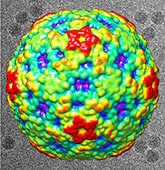Key points
- CDC laboratories routinely conduct testing for non-polio enteroviruses and parechoviruses.
- CDC and some health departments test with molecular sequencing methods, or a real-time reverse transcription polymerase chain reaction (rRT-PCR) lab test.
- Submissions to CDC for diagnostic testing require pre-approval.

Overview
Clinicians consider EV-D68 as a possible cause of acute, serious respiratory illness. If not already part of a typical diagnostic routine, lab tests should be done when the cause of respiratory infection in seriously ill patients is unclear.
Services and outreach
CDC laboratories routinely conduct testing for non-polio enteroviruses and parechoviruses, such as:
- Qualitative molecular testing; pan-enterovirus and pan-parechovirus.
- Molecular testing, followed by sequencing to identify enterovirus and parechovirus types (formerly serotypes).
- Testing for less common picornaviruses (excluding Hepatitis A).
The CDC helps state laboratories with testing by:
- Sharing new diagnostic technologies and providing training on how to perform these techniques.
- Helping them identify enteroviruses and par echoviruses they have been unable to test.
- Guiding how to properly collect and ship clinical specimens to the CDC for confirming and typing picornaviruses.
Contact CDC
Types of tests
Infection with non-polio enteroviruses or parechoviruses can be confirmed by:
- Polymerase chain reaction (PCR) assays and sequencing.
- Isolating the virus in cell culture, followed by PCR assays for virus identification.
Specimen collection overview
Non-polio enteroviruses and parechoviruses can be detected in stool or rectal swabs and respiratory specimens (including from the throat).
Depending on the symptoms, other specimen types such as cerebrospinal fluid, blister fluid, and blood can be collected for testing.
Submitting specimens
For EV-D68 testing, contact health department first
- Before submitting to CDC: Request pre-approval for all submission to CDC for diagnostic testing. This is because specimen submission requirements for CLIA diagnostic testing are currently being updated.
- Please contact [email protected] for testing non-AFM specimens.
- Please contact [email protected] before submitting any AFM specimens.
- Please contact [email protected] for testing non-AFM specimens.
- Preferred specimens: Submit nasopharyngeal and oropharyngeal swabs, or any other type of upper respiratory specimens.
- Specimen submission form: Complete CDC specimen submission form (CDC Form 50.34).
- Shipping and handling: Follow collection, storage, and shipment guidelines.
Interpreting results
A positive laboratory test for non-polio enteroviruses and parechoviruses from certain specimens, such as rectal or respiratory swab, does not necessarily mean the virus is the cause of infection. Non-polio enteroviruses and parechoviruses can be shed for several weeks after the symptoms have resolved.
- American Academy of Pediatrics. Section 3: Enterovirus (nonpoliovirus) – clinical manifestations. In Red Book: 2018 Report of the Committee on Infectious Diseases. 31st ed. Kimberlin DW, Brady MT, Jackson MA, Long SS, eds. Elk Grove Village, IL: American Academy of Pediatrics; 2018.
